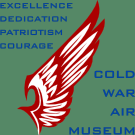 One thing that almost everyone with CJ experience will tell you is - "Its an honest, fun, low cost (as warbirds go) airplane to own and operate." This picture was taken years ago after I met another future director of this museum at an airshow in West Texas. Alternatively, I refer to this picture as "when I still had hair".
One thing that almost everyone with CJ experience will tell you is - "Its an honest, fun, low cost (as warbirds go) airplane to own and operate." This picture was taken years ago after I met another future director of this museum at an airshow in West Texas. Alternatively, I refer to this picture as "when I still had hair".The CJ falls between the T28 and T34 American trainers in size.

The larger T28 can outrun and outperform it, but at higher operating cost. The smaller T34 (A model) can keep up with it despite a smaller engine or (B model) outrun it because of its weight and size advantage. But again at a higher acquisition and maintenance cost.
After weighing a number of factors, I chose the Nanchang CJ as my "entry level warbird". A problem for early adopters was skepticism when the aircraft first began to be imported in the 80's. Back then, everyone called their plane a "Yak", referring to its Russian cousin, the Yak 18, because Chinese aircraft were a rareity. Now, no self respecting owner would refer to his CJ as a Yak (but almost every controller will call it that, its easier to say over the radio). Then there were only two CJs or Yaks flying in North Texas, now there are more than fifty within easy range of Lancaster Airport.
 One of the benefits of the CJ is that it makes "the right noises". The radial (or "round") engine has the distinctive rumbling sound of a WWII aircraft. Here the top and bottom cowls have been removed for easy all-around access to the engine. So many Americans and Canadians bought them that the Chinese government opened the factory back up to make and sell parts and even whole new airplanes
One of the benefits of the CJ is that it makes "the right noises". The radial (or "round") engine has the distinctive rumbling sound of a WWII aircraft. Here the top and bottom cowls have been removed for easy all-around access to the engine. So many Americans and Canadians bought them that the Chinese government opened the factory back up to make and sell parts and even whole new airplanesThe standard Chinese Army Air-Force paint scheme is an olive-drab green over blue. This airplane was repainted in a shinier, brighter version of the standard colors. The insignia shown is similar to the standard insignia but lacks the Chinese characters for "39" that belong in the red star, refering to the year of the "long march"

 Locals gave the plane the nickname "Kermit" because of the bright green color.
Locals gave the plane the nickname "Kermit" because of the bright green color. Like everything else on the "Chang", cockpit layout is basic and straightforward. The white line up the center of the panel gives the pilot a reference. In case of disorientation, align the stick with this line until you and the airplane get things sorted out.
Like everything else on the "Chang", cockpit layout is basic and straightforward. The white line up the center of the panel gives the pilot a reference. In case of disorientation, align the stick with this line until you and the airplane get things sorted out.Unfortunately, this particular airplane passed on to another owner and is no longer flying. More information and pictures on our current CJs can be found on the museum's CJ-6A web page. Or click on the CJ-6a label below for other blog posts about CJ's.



jordan 12
ReplyDeletemichael kors outlet online
yeezy shoes
nmd
cheap jordans
curry 6 shoes
hermes belt
fila shoes
nike air max
chrome hearts outlet